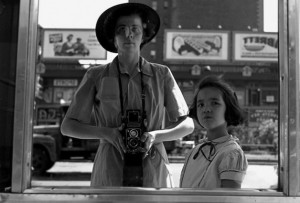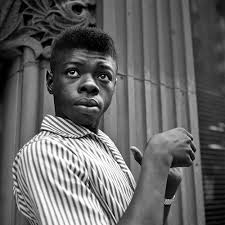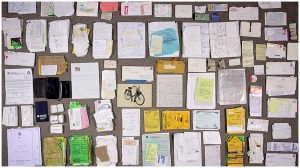 When John Maloof a Chicago historian found boxes of archival material amounting to boxes of more than 100,000 photos at a local auction that he thought would be good for his research, paying a reasonably small price of $380. He had no idea what he was in for when he started to develop and view the photos taken by one Vivian Maier. It turns out that he was sitting on a treasure trove of street photography dating from the 50s to the 90s, and according to photographer Mary Ellen Mark who is interviewed in this documentary, comparable to Helen Levitt, Robert Frank, Lisette Model, and Diane Arbus. The work itself is stunning and is a very honest, incisive, intimate, startling and sometimes humorous look at Chicago city life and its residents, her ever-present Rolleiflex camera (used till the early 70s) enabling her to make eye contact with her subjects and so perhaps making the pictures even more intimate. Many of them feature people who are vulnerable, poor, living on the margins and many of them feature children often upset, thoughtful or playful, as well as many self-portraits. She was also progressive in her desire to see the world as a single woman in the late 50s/early 60s going on a world tour taking in Asia and the Middle East, a trip which produced striking photographs worthy of the National Geographic.
When John Maloof a Chicago historian found boxes of archival material amounting to boxes of more than 100,000 photos at a local auction that he thought would be good for his research, paying a reasonably small price of $380. He had no idea what he was in for when he started to develop and view the photos taken by one Vivian Maier. It turns out that he was sitting on a treasure trove of street photography dating from the 50s to the 90s, and according to photographer Mary Ellen Mark who is interviewed in this documentary, comparable to Helen Levitt, Robert Frank, Lisette Model, and Diane Arbus. The work itself is stunning and is a very honest, incisive, intimate, startling and sometimes humorous look at Chicago city life and its residents, her ever-present Rolleiflex camera (used till the early 70s) enabling her to make eye contact with her subjects and so perhaps making the pictures even more intimate. Many of them feature people who are vulnerable, poor, living on the margins and many of them feature children often upset, thoughtful or playful, as well as many self-portraits. She was also progressive in her desire to see the world as a single woman in the late 50s/early 60s going on a world tour taking in Asia and the Middle East, a trip which produced striking photographs worthy of the National Geographic.
When Maloof saw these photos he immediately became possessed with the idea of finding out more about the person behind these
 stunning images. And as this intriguing documentary shows Vivian was certainly an interesting character worthy of a film. For one she was a full-time nanny who managed to take these photos whilst looking after her charges. And when I say looking after it was sometimes in the loosest sense of the word as the children she looked after now grown up testify. They were often dragged along to the most deprived slum areas, waiting around bored while she took her pictures, sometimes even losing them which must’ve been an absolute nightmare for the parents. It’s a wonder the families kept her on as long as they did, working for example with the Gensburgs family from 1956-72.
stunning images. And as this intriguing documentary shows Vivian was certainly an interesting character worthy of a film. For one she was a full-time nanny who managed to take these photos whilst looking after her charges. And when I say looking after it was sometimes in the loosest sense of the word as the children she looked after now grown up testify. They were often dragged along to the most deprived slum areas, waiting around bored while she took her pictures, sometimes even losing them which must’ve been an absolute nightmare for the parents. It’s a wonder the families kept her on as long as they did, working for example with the Gensburgs family from 1956-72.
Other more disturbing stories gradually emerge from the children she looked after, after the more rosy initial picture we get of Maier being loved by the children and being exciting and adventurous to them. One story in particular told by one of the children (now grown-up) has her being force fed by her in a terrifying manner, as well as being hit with a heavy book, leaving her still visibly shaken . So it’s not too surprising when we learn that she was most probably mentally ill, aligning with her unhealthy propensity to hoard things such as newspapers till the floor was sinking under their weight (reminding me a bit of another intriguing eccentric Drako Oho Zarharzar in the documentary The Man Whose Mind Exploded). When one of the children gave a house painter some of the newspapers she was vivid with rage, to the extent that the family had to fire her. She was also extremely secretive to the point where she would rig her room so she would know if it had been disturbed by someone. And thn there’s the fact she kept changing her name and according to some adopted an accent (although possibly real given her rural French background), as she said herself she fancied herself a ‘sort of a spy’. She would also play detective investigating scenes of a local murder in one film she made. And she would never show any of the pictures she took. A shame as they fetch quite the sum nowadays despite being refused by the major art institutions such as MOMA (as a frustrated Maloof relates on spurious grounds of being entirely posthumous work).
 There is a huge sadness about this strange reclusive woman, and that’s what haunts the most in this film. Afraid of men to the point of hysteria and constantly pointing out media stories of violent men, it indicates all too likely sexual trauma suffered as a child in France which was not dealt with. She lived out her days as a lonely spinster eating processed meat out of a tin on a park bench, with no family to turn to and hardly any friends, it makes those photos and her posthumous success painfully poignant, though whether she would’ve liked the fame is another thing altogether.
There is a huge sadness about this strange reclusive woman, and that’s what haunts the most in this film. Afraid of men to the point of hysteria and constantly pointing out media stories of violent men, it indicates all too likely sexual trauma suffered as a child in France which was not dealt with. She lived out her days as a lonely spinster eating processed meat out of a tin on a park bench, with no family to turn to and hardly any friends, it makes those photos and her posthumous success painfully poignant, though whether she would’ve liked the fame is another thing altogether.
DVD and Blu-Ray out Nov 11th.




